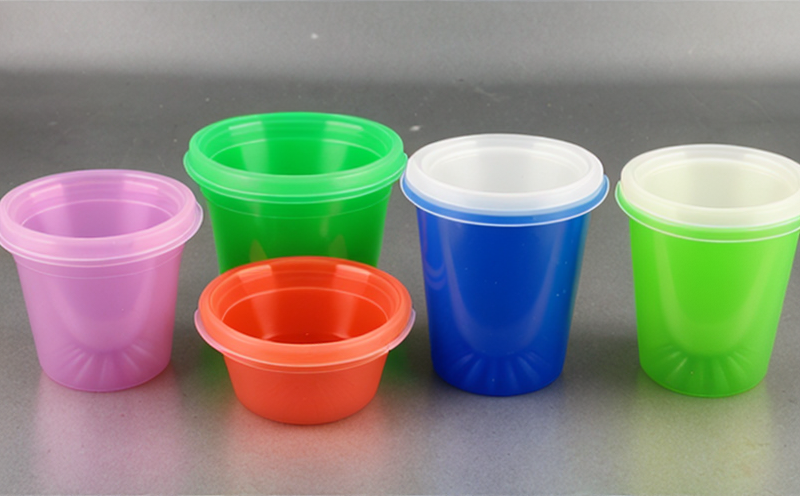ASTM D5511 Anaerobic Biodegradation Testing of Disposable Plastics
The ASTM D5511 standard method is a critical tool in the evaluation of the biodegradability of disposable plastics under anaerobic conditions. This testing procedure assesses whether a plastic material can be broken down by microorganisms into simpler compounds, such as carbon dioxide and water, within a specified period. The test involves exposing samples to an anaerobic environment, typically achieved through the use of a closed system that is flushed with a reducing atmosphere or placed in contact with an anaerobic inoculum.
ASTM D5511 testing is particularly relevant for materials intended to be disposed of in municipal landfills, where conditions are often anaerobic. This method helps manufacturers and regulators determine the environmental impact of disposable plastics by quantifying the rate at which these materials decompose under realistic landfill conditions. The test results can inform product design, guide regulatory compliance, and support claims about sustainable manufacturing processes.
The testing process involves several key steps: specimen preparation, inoculation with microorganisms, incubation in a controlled anaerobic environment, and periodic sampling for analysis. Specimens are typically prepared by cutting them into standardized pieces that can be easily handled and tested. The specimens are then placed in an anaerobic chamber or flask containing a defined inoculum of microorganisms.
The test proceeds over a set period (commonly 30 days), during which the samples are regularly monitored for changes in weight, color, and other physical properties indicative of biodegradation. At specified intervals, samples are removed from the anaerobic environment, analyzed, and weighed to determine the extent of mass loss due to microbial activity.
The results of ASTM D5511 testing can be used to calculate the biodegradation rate or degree of degradation. Compliance with this standard is essential for manufacturers aiming to meet regulatory requirements in various jurisdictions that mandate certain levels of biodegradability for disposable plastics. For instance, the European Union and several U.S. states have implemented regulations requiring products labeled as compostable to undergo ASTM D5511 testing.
The significance of ASTM D5511 lies not only in its role in regulatory compliance but also in its potential impact on product development. By understanding how different materials behave under anaerobic conditions, manufacturers can optimize their formulations for better biodegradability without compromising the functional properties required by consumers and industries.
- Key Parameters: Mass loss percentage, residual mass, rate of degradation
- Testing Environment: Anaerobic chamber or flask inoculated with microorganisms
- Sample Preparation: Standardized pieces cut from the plastic material for consistent testing
- Test Duration: Typically 30 days, but can vary based on specific regulatory requirements
Why It Matters
The importance of ASTM D5511 testing cannot be overstated in the context of sustainability and environmental responsibility. As concerns over plastic pollution grow globally, there is a heightened demand for materials that can contribute positively to waste management practices. Biodegradable plastics, when properly characterized through ASTM D5511 testing, offer an environmentally friendly alternative to conventional petroleum-based plastics.
The test results provide valuable insights into the biodegradation rates of disposable plastics under anaerobic conditions, which are typical in landfills where most plastic waste ends up. This information is crucial for several stakeholders:
- Manufacturers: They can use the data to refine their product formulations and improve the sustainability profile of their offerings.
- Regulators: Compliance with ASTM D5511 ensures that products labeled as biodegradable meet rigorous scientific standards, enhancing consumer trust in these claims.
- Environmentalists: Test results can inform policy decisions and guide the development of effective waste management strategies.
The test also plays a pivotal role in fostering innovation within the plastics industry. By identifying gaps between current materials and desired biodegradation performance, ASTM D5511 testing drives the creation of new, more sustainable products that can contribute to reducing environmental footprints.
Moreover, compliance with this standard is increasingly becoming a differentiating factor for brands seeking to align their offerings with consumer preferences for eco-friendly products. This trend reflects a broader shift towards sustainability in product development and manufacturing practices.
Quality and Reliability Assurance
- Inoculum Consistency: Ensuring that the microorganisms used are consistent across tests is crucial for reliable results. The inoculum should be standardized to minimize variability in test outcomes.
- Environmental Control: Maintaining strict control over environmental parameters such as temperature and humidity within the anaerobic chamber helps ensure accurate biodegradation assessment.
- Data Recording: Comprehensive documentation of all test parameters, including initial specimen weight, incubation conditions, and periodic samples, is essential for reproducibility and verification.
- Inter-laboratory Comparison: Participating in inter-laboratory comparisons can help validate the reliability and accuracy of ASTM D5511 testing within a laboratory setting.
The quality and reliability of ASTM D5511 testing are paramount for ensuring that test results are both accurate and reproducible. By adhering to strict protocols and maintaining rigorous quality control measures, laboratories can provide reliable data that contribute to informed decision-making across various sectors.
International Acceptance and Recognition
The ASTM D5511 standard is widely recognized and accepted internationally for its role in assessing the anaerobic biodegradability of disposable plastics. This standard has been adopted by several countries, including the United States, Canada, and various European nations.
In Europe, compliance with ASTM D5511 testing is often a requirement for products to be labeled as compostable under specific regulations such as EN 13432. Similarly, in the U.S., ASTM D5511 testing is frequently required by state-level regulations aimed at reducing plastic waste.
The standard's acceptance extends beyond regulatory compliance; it also influences consumer behavior and market trends. Products that meet ASTM D5511 standards are often perceived as more environmentally friendly and may command premium pricing or greater consumer loyalty.
Furthermore, the widespread use of this standard fosters global collaboration in waste management and sustainability initiatives. By adhering to a universally accepted methodology, laboratories contribute to consistent data across different regions, facilitating better-informed decisions on material selection and disposal practices.





